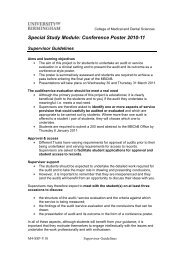Contents - College of Medical and Dental Sciences - University of ...
Contents - College of Medical and Dental Sciences - University of ...
Contents - College of Medical and Dental Sciences - University of ...
Create successful ePaper yourself
Turn your PDF publications into a flip-book with our unique Google optimized e-Paper software.
The 11 th International Workshop on KSHV & Related Agents, Birmingham, UK<br />
Pathogenesis Abstract 14<br />
GENERATION OF RHESUS RHADINOVIRUS LACKING EXPRESSION OF VGPCR<br />
AND VCD200 FOR THE ASSESSMENT OF THEIR ROLES IN DISEASE<br />
DEVELOPMENT IN A RHESUS MACAQUE MODEL OF KSHV INFECTION<br />
Ryan D. Estep 1<br />
, Elisa Cardenas 3 , <strong>and</strong> Scott W. Wong 1,2,3<br />
Vaccine <strong>and</strong> Gene Therapy Institute1 , Oregon Health & Science <strong>University</strong> West Campus,<br />
Division <strong>of</strong> Pathobiology <strong>and</strong> Immunology2 , Oregon National Primate Research Center,<br />
Beaverton, Oregon 97006;<br />
Department <strong>of</strong> Molecular Microbiology <strong>and</strong> Immunology3 , Oregon Health & Science<br />
<strong>University</strong>, Portl<strong>and</strong>, Oregon 97201.<br />
Abstract<br />
RRV strain 17577, the rhesus macaque homologue <strong>of</strong> KSHV, was recently cloned as an<br />
infectious Bacterial Artificial Chromosome (BAC). The RRV BAC system allows for the<br />
rapid genetic manipulation <strong>of</strong> the RRV genome in bacteria, <strong>and</strong> the subsequent<br />
production <strong>of</strong> modified forms <strong>of</strong> RRV. Currently, we are using the RRV BAC system to<br />
modify genes that have been proposed to be important in the development <strong>of</strong> disease<br />
associated with KSHV infection in humans. KSHV <strong>and</strong> RRV both encode a viral G proteincoupled<br />
receptor (vGPCR) <strong>and</strong> viral CD200 homologue (vCD200), proteins which possess<br />
oncogenic <strong>and</strong> immunomodulatory functions, respectively. Although extensively analyzed<br />
in vitro, the roles that the KSHV <strong>and</strong> RRV vGPCR <strong>and</strong> vCD200 proteins play during a de<br />
novo infection in vivo are currently unknown. Therefore, we have used the RRV BAC<br />
system to disrupt expression <strong>of</strong> the vGPCR <strong>and</strong> vCD200 proteins in RRV, through the<br />
insertion <strong>of</strong> specific stop mutations in ORF74 <strong>and</strong> R15. Thus far, we have successfully<br />
generated viruses that no longer express these proteins during infection, <strong>and</strong> preliminary<br />
analyses indicate that viruses devoid <strong>of</strong> vGPCR or vCD200 expression possess similar<br />
growth properties to wild-type RRV in vitro. Other ongoing studies with these viruses<br />
include examination <strong>of</strong> the effects <strong>of</strong> vGPCR <strong>and</strong>/or vCD200 expression on virus-induced<br />
signaling <strong>and</strong> immunoregulatory properties in vitro, <strong>and</strong> importantly, how lack <strong>of</strong> these<br />
proteins may affect the development <strong>of</strong> viral-induced disease in vivo. Further plans<br />
include the generation <strong>of</strong> chimeric versions <strong>of</strong> RRV expressing KSHV vGPCR <strong>and</strong>/or<br />
vCD200.<br />
Presenting author Email: estepr@ohsu.edu<br />
36















